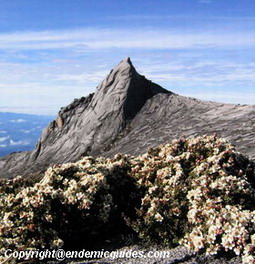|
Welcome To
Mt KINABALU NP
PAGE - SABAH
|

Introduction and
History
Kinabalu Park was established in 1964 and covers an
area of 750 square kilometers (300 square miles).
Two expeditions to explore the mountain and its
flora in 1961 and 1964 were led by Professor John
Corner, on behalf of the Royal Society of London,
which led to the formation of Kinabalu Park.
The
Park is situated in the East Malaysian state of
Sabah (British North Borneo before 1963) and
stretches through the entire west coast of Sabah.
Its highest peak is Mount Kinabalu standing at 4101
meters (13,455 feet) visible from the South China
Sea. Being the world’s youngest granite pluton, it
continues to rise 5mm/year.
The
lowest elevation in Kinabalu Park is at Poring Hot
Springs (550 meters/1,805 feet), which lies near the
Park’s southern boundary. Therefore temperatures
decrease from 25° C hot and humid at Poring to a
cool and crisp 4°C at Mount Kinabalu’s summit. The
climatic changes provide a diverse range of habitats
for thousands of plant species.
Due
to the high altitude, clouds are trapped in many
parts of the Park and heavy rainfall occurs for
several months of the year from October to January
while February to May are generally the driest
months. A common climatic feature of the Park, are
bright early mornings, followed by clouds
mid-morning which obscure the mountains by mid-day.

PHYSICAL FEATURES
Mount Kinabalu is the tallest Malaysian mountain.
The next two highest peaks being Mount Trus Madi
(8,666 feet) and Mount Tambuyukon (8,462 feet)
located 50 kilometers south and 20 kilometers north
of Mt Kinabalu respectively. A total of six unique
major topographical features occur with Kinabalu
Park. These include peaks and plateaus, gullies,
rivers, streams and waterfalls, hot springs, caves (Paka
Caves and the tumbled bats cave at Poring) and
granite slabs, a characteristic of the slopes of the
summit.

Mount Kinabalu comprises an oval-shaped granite dome
which resulted 1.5 million years ago by volcanic,
tectonic and geological processes. Rapid uplift
followed by glacial erosion during the Ice Age
contributed to the smooth rock surface, which is
well graded and paved at the summit. Low's Gully is
the most spectacular feature of the mountain
spliting it into two peak forming the Western and
Eastern Summit Plateau.
FLORA AND FAUNA
Kinabalu Park has essentially four main vegetation
zones. However, these zones are localized
variations depending on factors such as soil type,
terrain, presence or absence of soils, proximity to
streams and degree of exposure to sunlight. At
altitudes above 1200 meters (4,000 feet) it is a
place for plants of Himalayan and Chinese genera and
for plants of Australian and New Zealand and even
American affinity which consist of, among others,
buttercups (of Australian affinity), the Rosaceous
trees and shrubs and Violets (both of which are of
Sino-Himalayan affinity) and they mingle with
pitcher plants (Nepenthes) and bamboos of Bornean
origins.

A
recent study by Beaman & Beaman (1998) found that
Kinabalu contains as many as 5,000 to 6,000 species,
comprising of over 200 families. More than half (78
species) of the 135 species of Ficus can be found at
the site making Mount Kinabalu one of the richest
and most diverse assemblages of plants in the world.
There are believed to be 1,000 orchid species,
including at least five species of slipper orchid,
of the genus Papiopedillium, perhaps the most famous
orchid species found on Kinabalu, but they are
rarely seen due to intensive collecting for
commercial use. Other magnificent orchids are mainly
Eria, Bulbophyllum, Dendrobium, Liparis,
Dendrochilum, Pholidota, and Coelogyne.
Over
600 fern species are found within the Park,
comprising of tree ferns, shade ferns, thicket
ferns, epiphytic ferns and tiny scrub ferns. Nest
ferns (Asplenium nidus) are found on every walk at
the Park.
One
of the rarest plants in the world – the Rafflesia is
only found in very few locations in Borneo. Named
after Sir Stamford Raffles (who founded Singapore in
1819), it is the largest flower in the world. Two
species, R. Keithii and R. Pricei have been found in
the Park in the Poring Hot Springs area. In recent
years, a third species, R. Tengku-Adlini was
discovered.
Continue Page 2 >>
|